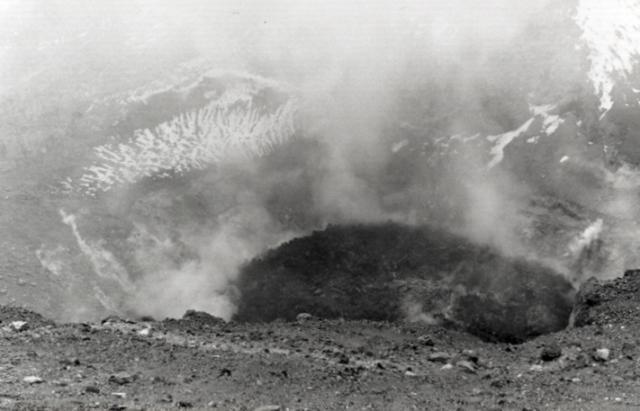Report on Lascar (Chile) — June 1989
Scientific Event Alert Network Bulletin, vol. 14, no. 6 (June 1989)
Managing Editor: Lindsay McClelland.
Lascar (Chile) Continued lava dome growth
Please cite this report as:
Global Volcanism Program, 1989. Report on Lascar (Chile) (McClelland, L., ed.). Scientific Event Alert Network Bulletin, 14:6. Smithsonian Institution. https://doi.org/10.5479/si.GVP.SEAN198906-355100
Lascar
Chile
23.37°S, 67.73°W; summit elev. 5592 m
All times are local (unless otherwise noted)
A lava dome has been growing in the active summit crater, site of occasional tephra emission since 1986. Observations and pictures from Stephen Foot (MINSAL, Ltda.), who climbed the volcano on 18 April 1989, confirm Paul King's February 1989 report of a steaming lava dome (14:3). The photographs clearly show a dome growing in the W crater of the eastern of Lascar's two andesite cones (figure 1). Until early 1986, this crater was empty, with only solfataric and fumarolic activity. Foot's photographs show that by April 1989 the dome had reached an estimated 200 m in diameter and 50 m height. The dome had steep sides and a blocky, steamy, dark brown surface. Steam emissions of different intensities were still being continuously released in late June, and glow was visible from Toconao (~30 km away) on one occasion.
 |
Figure 1. Photograph of the growing lava dome in Lascar's summit crater, 18 April 1989, by Stephen Foot. Courtesy of M. Gardeweg. |
Geological Summary. Láscar is the most active volcano of the northern Chilean Andes. The andesitic-to-dacitic stratovolcano contains six overlapping summit craters. Prominent lava flows descend its NW flanks. An older, higher stratovolcano 5 km E, Volcán Aguas Calientes, displays a well-developed summit crater and a probable Holocene lava flow near its summit (de Silva and Francis, 1991). Láscar consists of two major edifices; activity began at the eastern volcano and then shifted to the western cone. The largest eruption took place about 26,500 years ago, and following the eruption of the Tumbres scoria flow about 9000 years ago, activity shifted back to the eastern edifice, where three overlapping craters were formed. Frequent small-to-moderate explosive eruptions have been recorded since the mid-19th century, along with periodic larger eruptions that produced ashfall hundreds of kilometers away. The largest historical eruption took place in 1993, producing pyroclastic flows to 8.5 km NW of the summit and ashfall in Buenos Aires.
Information Contacts: M. Gardeweg, SERNAGEOMIN, Santiago; S. Foot, MINSAL Ltda., Santiago.

